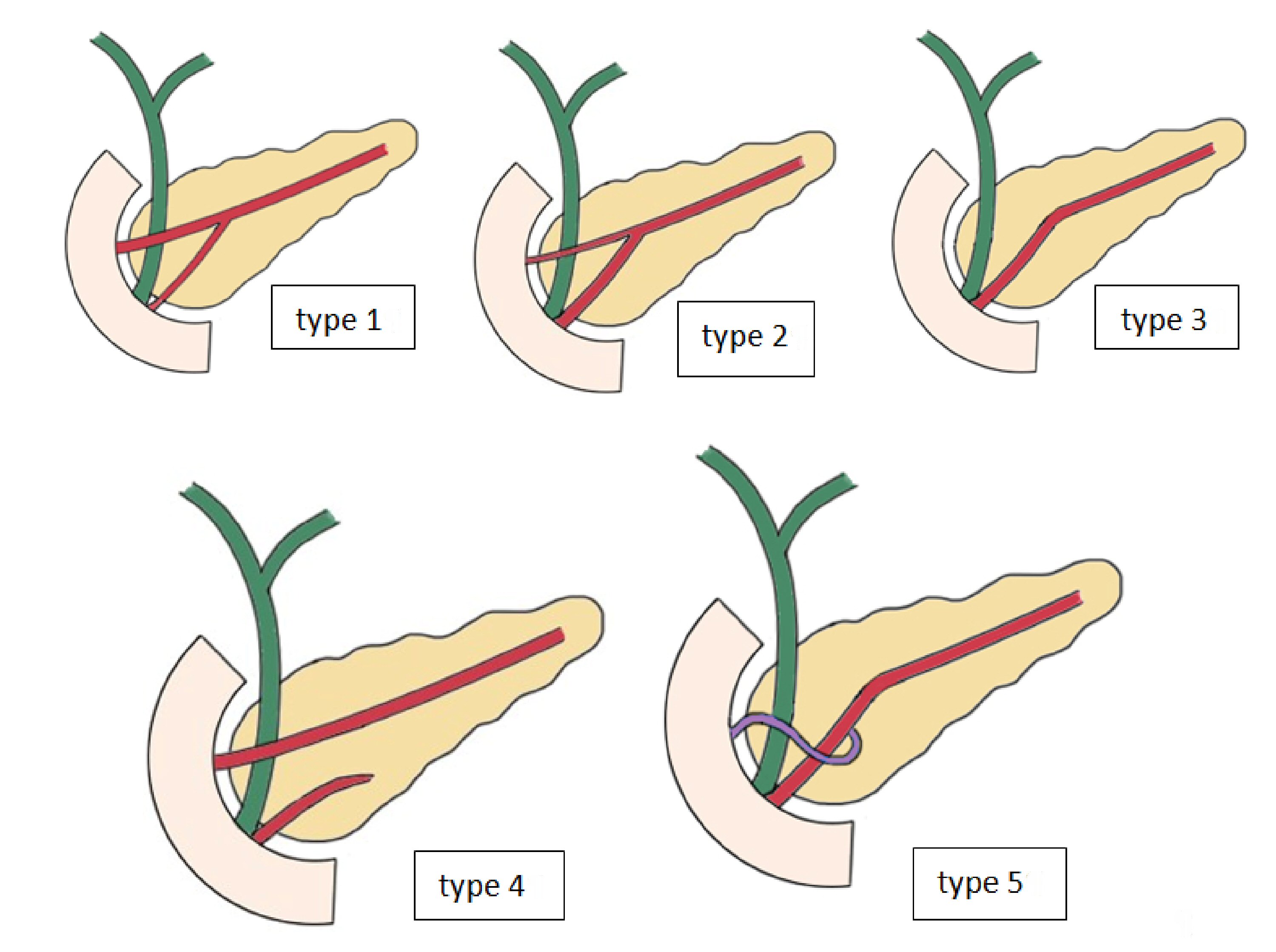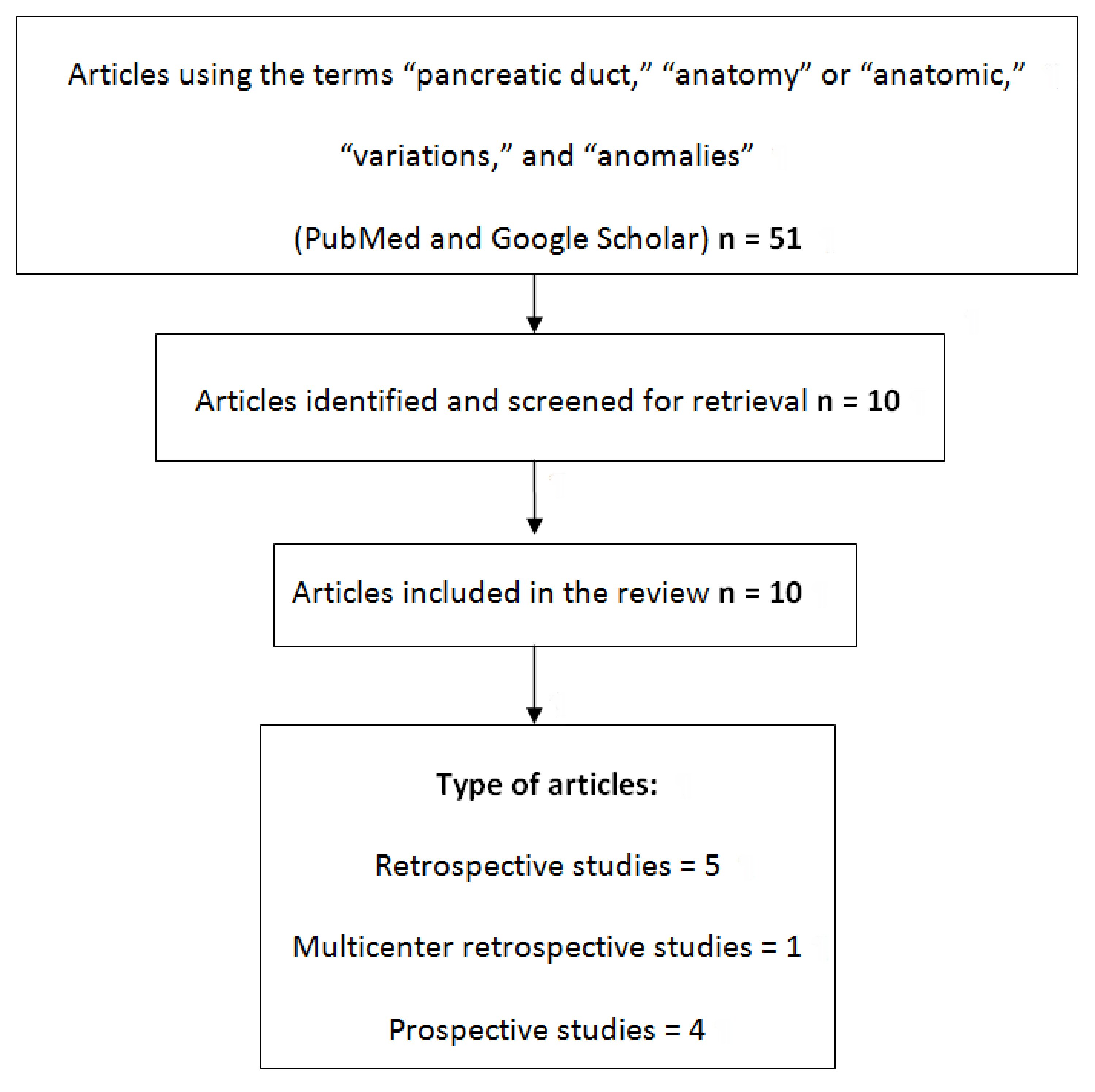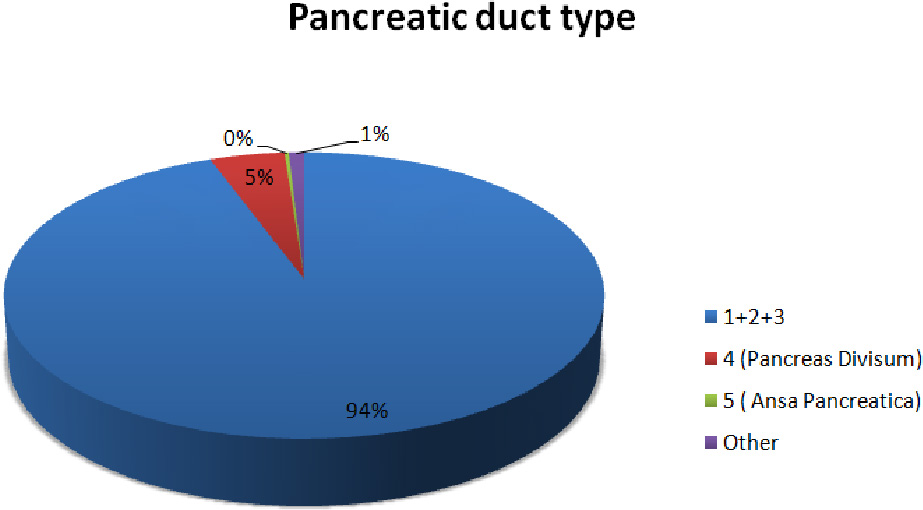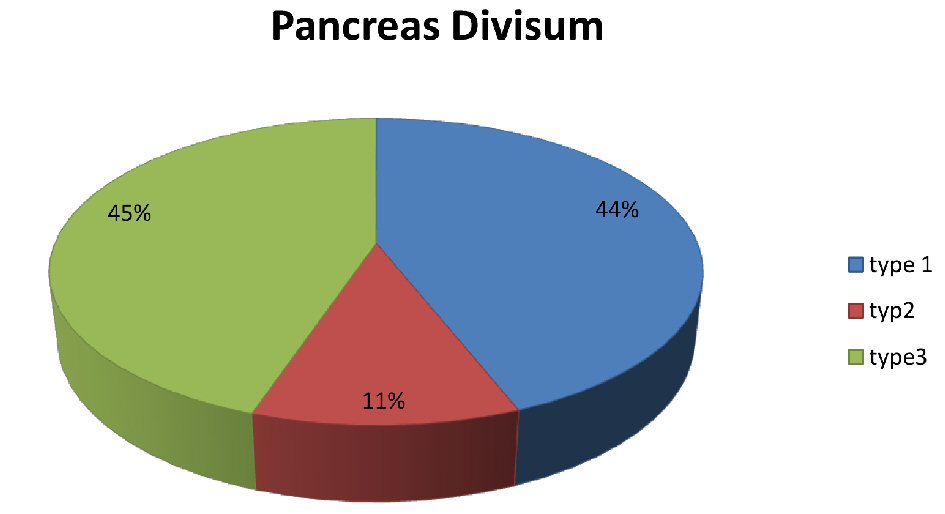
Figure 1. Drawings showing different types of pancreatic duct configuration.
| Journal of Clinical Medicine Research, ISSN 1918-3003 print, 1918-3011 online, Open Access |
| Article copyright, the authors; Journal compilation copyright, J Clin Med Res and Elmer Press Inc |
| Journal website http://www.jocmr.org |
Review
Volume 10, Number 5, May 2018, pages 370-375
The Main Anatomical Variations of the Pancreatic Duct System: Review of the Literature and Its Importance in Surgical Practice
Figures




Tables
| Author | No. of subjects | Type of subjects | Type of investigation | Type of article |
|---|---|---|---|---|
| *Only some of the patients included in the article were suitable for imaging of the pancreatic duct system. ERCP: endoscopic retrograde cholangiopancreatography; MRCP: magnetic resonance cholangiopancreatography. | ||||
| Filippo et al [3] | 350 | Living patient | MRCP | Prospective study |
| Adibelli et al [4] | 1,158 | Living patient | MRCP | Retrospective cohort study |
| Bulow et al [5] | 927 | Healthy volunteers | Stimulating MRCP | Prospective study |
| Bang et al [7] | 582 | Living patient | ERCP | Retrospective cohort study |
| Kamisawa et al [9] | 256/3,210* | Living patient | ERCP | Retrospective cohort study |
| Shahriah et al [10] | 65 | Cadaver | Autopsy of specimens | Prospective study |
| Kim HJ et al [11] | 4,097/10,243* | Living patient | ERCP | Multicenter retrospective cohort study |
| Oracz et al [12] | 300 | Living patient | Medical records (non specified) | Retrospective cohort study |
| Uomo et al [13] | 485/650* | Living patient | ERCP | Retrospective cohort study |
| Prasanna et al [14] | 40 | Cadaver | Autopsy of specimens | Prospective study |
| Author | No. of subjects examined | Type of subjects | No. of normal | Pancreas divisum | Other specific types of anomalies |
|---|---|---|---|---|---|
| Filippo et al [3] | 350 | Living patient | 321 | 18 | 11 |
| Adibelli et al [4] | 1,158 | Living patient | 1,091 | 54 | 13 |
| Bulow et al [5] | 927 | Healthy volunteers | 838 | 89 | - |
| Bang et al [7] | 582 | Living patient | 531 | 19 | 32 |
| Kamisawa et al[9] | 256/3,210 | Living patient | 175 | 81 | - |
| Shahriah et al [10] | 65 | Cadaver | 55 | 9 | 1 |
| Kim HJ et al [11] | 4,097/10,243 | Living patient | 4,054 | 40 | 3 |
| Oracz et al [12] | 300 | Living patient | 252 | 33 | 15 |
| Uomo et al [13] | 485/650 | Living patient | 437 | 26 | 22 |
| Prasanna et al [14] | 40 | Cadaver | 38 | 2 | - |
| Total | 8,260 | 8 living patients | 7,792 (94.3%) | 371 (4.5%) | 97 (1.2%) |
| 1 healthy volunteers | |||||
| 2 cadavers |
| Author | No. of subjects examined | Type 1 | Type 2 | Type 3 | Type 4 | Type 5 | Other specific types of anomalies |
|---|---|---|---|---|---|---|---|
| *Patients with type 1, type2 and type 3 were not discriminated due to the different type of classification. +Patients that could not be classified in one of the described types according to the classification that was used in this article. ∧Patients with APBU were not discriminated from the types 1 to 5 but they were reported separately. | |||||||
| Adibelli et al [4] | 1,158 | 521 (45%) | 42 (3.6%) | 528 (45.6%) | 54 (4.6%) | 13 (1.2%) | No annular pancreas, agenesis, hypoplasia, dorsal pancreas, accessory lobe, 2APBU (0.17%)∧ |
| Bulow et al [5] | 927 | 209 (22.5%) | 45 (4.8%)+ | 584 (63%) | 89 (9.6%) | - | - |
| Shahriah et al [10] | 65 | 5 (7.69%) | 3 (4.6%) | 47 (72.3%) | 9 (13.8%) | - | 1 duct in 3d papilla |
| Bang et al [7] | 582 | 531 (91,2%)* non corresponding types | 19 (3.3%) | - | 32 (5.5%) duplication anomalies (5 number - 27 form variants) | ||
| Filippo et al [3] | 350 | 321 (91.8%) non specified type | 18 (5.2%) | - | 11 ABPU (3%) no annular | ||
| Prasanna et al [14] | 40 | 38 (95%) | Excluded from study | 2 (5%) | - | - | |
| Kamisawa et al [9] | 256/3,210 | 175 (68.3%) non specified type | 81 (31.6%) | - | 74 ABPU (28.9%)∧ | ||
| Uomo et al [13] | 485/650 | 437 (90,1%) non specified type | 26 (5.3%) | - | 22 Duplications (13 bifid MPD, 4 loop, 2 N-shaped, 3 ring shaped ) | ||
| Kim HJ et al [11] | 4,097/10,243 | 1,216 (37.7%) non specified type but with APD | 2,838 (69.3%) | 40 (0.49%) | - | 2 annular (0.05%), 1 santorinocele, 30 APBU (4.1%)∧ | |
| Oracz et al [12] | 300 | 252 (84%) non specified type | 33 (11%) | 8 (2.7%) | 4 ABPU, 3 rare (1%) anomalies | ||
| Total | 8,260 | 7,792 (94.3%) | 371 (4.5%) | 21 (0.25%) | 76 (0.92%) | ||
| Pancreas divisum | Type 1 | Type 2 | Type 3 |
|---|---|---|---|
| Adibelli et al [4] | 24 | 20 | 10 |
| Bang et al [7] | 12 | - | 7 |
| Bulow et al [5] | 67 | - | 89 |
| Kamisawa et al [9] | 16 | 10 | 15 |
| Total | 119 (44%) | 30 (11.11%) | 121 (44.8%) |